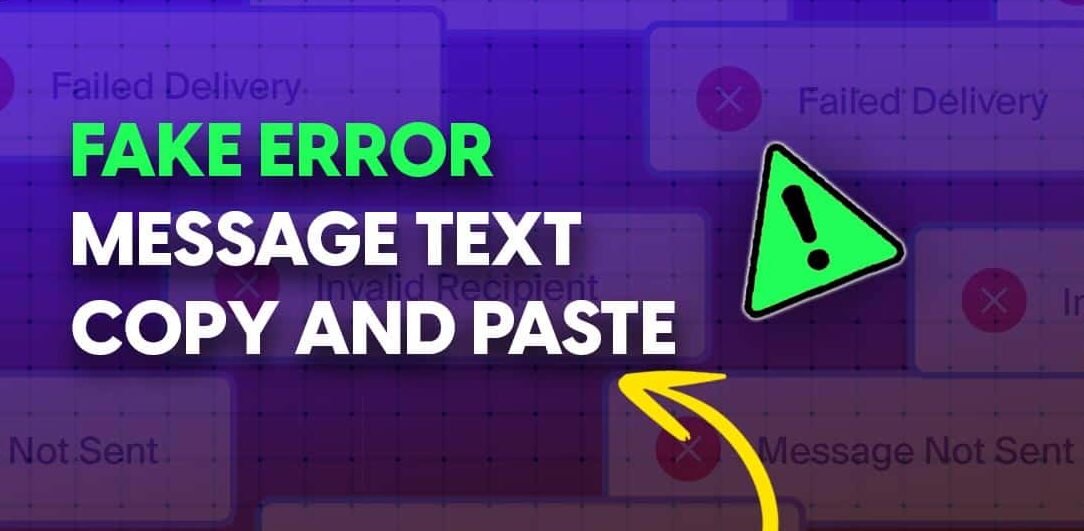Have you ever received an error message that left you scratching your head in befuddlement? Perhaps you were duped by a trickster who expertly produced a fake error message expressly to deceive you. From keyboard problems to replicating the feared “Blue Screen of Death” to fake virus alarms, these innocuous pranks are all over the internet. The start establishes the tone for a humorous discussion of these pranks, emphasizing appropriate use and the significance of exposing the joke once the laughing has died down.
In this blog post, we look at some amusing and inventive fake error message text copy and paste ideas for pranking people and adding fun to computer interactions. Let’s look at some hilarious and imaginative fake error message text copy and paste ideas that are sure to make you and your friends giggle.
- What is a Fake Error Message Text?
- What is the Purpose of a Fake Error Message in 2023?
- Examples of System-Generated Fake Error Messages Text Copy And Paste
- T-Mobile Fake Error Message Text Examples
- Syntax Fake Error Message Text Examples
- Fake Error Messages Examples for Tech-Savvy Users
- Automating Fake Disconnected Text Messages
- How to Safeguard Yourself Against Fake Error Messages
- Conclusion
What is a Fake Error Message Text?
Imagine this scenario: you’re working on your computer, minding your own thing, when suddenly a pop-up window arrives. According to the notice, your computer has suffered a serious issue and all of your files will be erased. These messages are designed to trick people into performing specified activities or to create a sense of urgency or fear to control them. Panic creeps in, and you scramble for a solution before it’s too late.
These innocuous fake error message text copy and paste ideas are designed to trick even the most tech-savvy acquaintances. The options are unlimited, ranging from amusing messages that make fun of typical computer errors to absurd assertions that test the borders of belief.
The “Keyboard Malfunction” glitch prank is a common fake error message text copy and paste concept. Imagine your pal casually typing away on their keyboard when all of a sudden, every key they hit causes a random character glitch. As they attempt to form a single logical sentence, their exasperation builds.
Another amusing concept is the “Blue Screen of Death” hoax. We’ve all seen this awful error message appear on our computer displays. But what if you could make it appear on the screen of someone else? With a simple copy and paste, you can make a fake blue screen of death that will have your friends doubting the stability of their PC.
The “Virus Detected” ploy is guaranteed to amuse the more nefarious pranksters out there. Consider a buddy perusing the internet when a pop-up window opens, informing them that a dangerous virus has infected their machine. Panic ensues, as they rush to find a solution.
What is the Purpose of a Fake Error Message in 2023?
There are various reasons why someone would need to use fake error messages. Here are five such instances in which false error messages might be used:
- Phishing and Scams:
Fake error messages can be used in phishing campaigns or scams to trick people into disclosing personal information such as usernames, passwords, or financial information. These messages may claim that there is a problem with an account or service, enticing consumers into supplying personal information.
- Malware Distribution:
False error messages can be used to spread malware. Users may be directed to download what looks to be a software update or security patch by these messages. The downloaded file, however, may include malicious software that compromises the user’s machine.
- Tech Support Scams:
Scammers may create Fake blocked messages to deceive users into believing their devices are having serious troubles. As a result, they may give bogus tech support services, such as enticing customers to pay for unnecessary patches or granting remote access to their machines, allowing hazardous malware to be installed.
- Social Engineering:
Fake error messages can be used in social engineering tactics that take advantage of human psychology. Scammers can influence people into taking urgent actions that benefit the attacker by creating a sense of urgency, panic, or terror.
While there may be acceptable reasons for producing fake error messages, such as in testing and development settings, utilizing them for malevolent purposes might result in legal ramifications and harm to persons. As a result, it is critical to apply appropriate and ethical methods when contemplating the usage of fake error messages.
Examples of System-Generated Fake Error Messages Text Copy And Paste
The following examples of fake error messages are intended to provide you with a general understanding of what these messages might be. You can copy and paste these to prank your friends!
1. [ATT MESSAGE CENTER] Message Unavailable:
Your message could not be delivered. Additional charges may apply. Error Code: 115.
2. Blocked Message Alert:
Your message to [Enter Target Name] has been blocked due to suspicious content. Error 703.
3. Connection Error:
Your message could not be sent due to a temporary network issue. Error 502.
4. Recipient Unavailable:
The recipient at [Enter Target Number] is currently out of reach. Please try again later. Error 8001.
5. Message Delayed:
Your message to [Enter Target Name] has been delayed and is pending delivery. Error 604.
6. Security Alert:
Your message contains sensitive information and is under review. Error 801.
7. Service Unavailable:
Due to high traffic, messaging services are currently down. Error 9003.
8. Delivery Failure:
We were unable to deliver your message to [Enter Target Number]. Error 606.
9. Verification Required:
To continue sending messages, please verify your identity. Error 5008.
10. Account Suspension:
Your messaging privileges have been temporarily suspended. Error 401.
11. [Network Error] Message Not Sent:
Your message could not be sent due to a network issue. Error Code: 503.
12. [Blocked Message Center]
Blocked Sender Alert: Your message to [Enter Target Name] has been blocked at the sender’s request. Error 704.
13. [Delivery Delay] Message Delayed:
Your message is currently in a queue and will be delivered shortly. Error 605.
14. [Content Filter] Message Quarantined:
Your message contains flagged content and has been temporarily withheld. Error 802.
15. [Authentication Error] Invalid Credentials:
Authentication failed. Please re-enter your login information. Error 5001.
16. [Server Overload] Server Busy:
Our servers are currently overloaded. Please try your message again later. Error 9004.
17. [Data Limit Exceeded] Data Usage Limit Reached:
You’ve exceeded your data limit for sending messages. Error 607.
18. [Verification Code Required] Security Verification:
To continue using messaging services, please enter the verification code sent to your email. Error 5009.
19. [Temporary Outage] Service Disruption:
Messaging services are temporarily unavailable due to maintenance. Error 9010.
20. [Blocked Contact] Message Not Delivered:
The recipient has blocked all messages from this sender. Error 703.
PRO TIP: To automate the process of sending fake error messages, consider using Google Voice or YouMail for a seamless and convincing prank experience.
T-Mobile Fake Error Message Text Examples
There is nothing wrong with playing with T-Mobile’s fake error message text. Copy and paste these examples to make friends fool:
1. “Call Dropped!” Connection Lost:
Your call has been mysteriously dropped. Blame it on the invisible phone gremlins!
2. “Emergency Broadcast Alert!” Incoming Call from Aliens:
We’ve detected an incoming call from extraterrestrial beings. Prepare for an intergalactic conversation!
3. “Data Overload!” Data Consumption Alert:
Your data usage has exceeded the limit. Brace yourself for an onslaught of cat videos!
4. “Network Hiccup!” Temporary Signal Disruption:
Our network just did a little dance move. Expect a brief pause in your call.
5. “Roaming in the Bermuda Triangle!” Mysterious Location:
Your phone has entered the Bermuda Triangle. Calls may be subject to time warps and mysterious disappearances.
6. “Out of Service Area!” Lost in the Wilderness:
You’ve ventured into an area without network coverage. It’s just you and nature now!
7. “Quantum Call Delay!” Time-Traveling Call:
Your call is currently caught in a temporal rift. It will reach its destination… eventually.
8. “Smartphone Rebellion!” Device Uprising:
Your phone has initiated a rebellion against humans. Expect sporadic behavior for the next few minutes.
9. “Voice to Text Confusion!” Auto-Correct Gone Wild:
Your voice message has been hilariously auto-corrected. Prepare for some unexpected laughter!
10. “Secret Agent Mode!” Undercover Call:
Your call is now in secret agent mode. Speak in your best spy voice for maximum effect.
These T-Mobile fake error messages are all in good fun and intended to bring laughter. Always use them responsibly and be sure to reveal the prank to your friends once the amusement has run its course!
Syntax Fake Error Message Text Examples
You can also send them a “Syntax Error” message to prevent them from sending you too many irrelevant messages. This type of error message will serve as a warning to the sender.
1. [Syntax Error] Warning – Blocked Number:
Your number has been temporarily blocked due to excessive spam reports. Please contact your mobile carrier for assistance.
2. [Error E-1301] Blocked Sender Alert:
The recipient has invoked a blocking mechanism. Your message “&message%blocked/” could not be delivered.
3. [Message Blocking] Attention T-Mobile Users:
Message blocking is currently active on this account. Please refrain from sending further messages.
4. [Syntax Error Message] AT&T Message Block:
Email text messages to this recipient have been blocked. Error Code: 112.
5. [Blocked Number] Recipient’s Shield:
Your message was halted in its tracks. This user has instituted a blocking protocol.
6. [Error 404] Message Not Found:
Sorry, but it seems your message got lost in the digital wilderness. Please try again later.
7. [Syntax Issue] Communication Error:
Your message encountered a syntax issue and couldn’t be processed. Verify your message format and try again.
8. [Blocked Contact] Blocked by Recipient:
Your number has been added to the blocked list. Messages from you will not go through.
9. [Security Alert] Suspicious Content Detected:
Your message was flagged as potentially suspicious and has been withheld for review.
10. [Error 503] Service Unavailable:
The recipient’s messaging service is temporarily unavailable. Your message could not be delivered at this time.
These syntax fake error messages can serve as gentle warnings or playful deterrents to curb irrelevant messages. Use them wisely and consider the context when sending them to your contacts.
Fake Error Messages Examples for Tech-Savvy Users
To prank your tech-savvy friends or family members, you may need to create fake error messages that are more convincing and sophisticated.
1. “Low-Level Exception Detected” Error:
Exception 0x0001C3F9. Execute emergency code dump.
2. “Kernel Overload” Critical Error:
Kernel overload detected. CPU meltdown is imminent.
3. “Data Matrix Corruption” Error:
The data matrix was corrupted. Bitstream integrity is compromised.
4. “Cipher Discrepancy” Security Alert:
Cipher mismatch detected. Protocol terminated.
5. “Quantum Tunneling Error” Error:
Quantum tunneling interference was detected. Resetting quantum state.
6. “IPv6 Collision Detected” Network Error:
IPv6 address collision detected. Initiating collision resolution protocol.
7. “Memory Stack Overflow” Error:
Memory stack overflow. Recursion limit exceeded.
8. “AI Autonomy Breach” Critical Alert:
AI autonomy breach. Isolating rogue subroutine.
9. “Crypto Hash Mismatch” Security Breach:
Crypto hash mismatch detected. Isolating potentially compromised data.
10. “Algorithmic Paradox” Error:
Algorithmic paradox detected. Rebooting logical subsystems.
These fake error messages employ technical language and terminology familiar to those well-versed in computer and technology systems. They are crafted to appear as authentic error messages that could arise during advanced tech scenarios, making them perfect for pranking your tech-savvy friends or family members.
Automating Fake Disconnected Text Messages
While manually copying and pasting fake messages for pranks can be fun, if you have other purposes in mind and want to make a realistic fake error message, there are more sophisticated ways to send such messages that can appear more legitimate. Here are two methods to consider:
#1. Block Their Number for Real
You can block the recipient’s phone number if you want the message to appear as real as possible. This may appear excessive at first, but keep in mind that you can always reverse the block when you’re ready to unveil the joke. After all, the purpose is to provide the appearance of genuineness.
Here’s how to block a contact on your device:
- Open your text messaging app, the one you use for regular texting.
- Locate the contact you want to block.
- Tap on their name at the top of the chat screen.
- This will bring up chat options, including the option to block the user.
- Confirm the block.
Now, when the person tries to send you a message, they will receive an error message indicating that they have been disconnected.
#2. Set Up Call Forwarding with Google Voice
Another option is to utilize Google Audio to send texts or audio messages stating that a phone number is unavailable. Google Voice gives you control and freedom over how you manage these communications.
Here’s how to set up Google Voice for automated fake disconnected text messages:
- Start by setting up a new Google Voice phone number. You can get a Google Voice number for free or at a low cost, depending on your preferences.
- Visit the Google Voice website and sign up for a personal number.
- Once you have a Google Voice number, configure it to forward calls to your cell phone. You can customize call forwarding rules to suit your needs.
By using Google Voice, you can automate the process of sending messages that make it appear as if the number is disconnected or unavailable.
How to Safeguard Yourself Against Fake Error Messages
To effectively protect yourself from fake error messages, follow these essential tips:
- Utilize Firewall and Antivirus Software:
Install and update reliable firewall and antivirus software on your devices regularly. Firewalls serve as barriers, preventing unwanted access, whereas antivirus software identifies and eliminates malware, including bogus error messages containing malicious code.
- Safeguard Personal Information:
When disclosing sensitive personal information such as credit card details, Social Security numbers, and passwords, use caution. Such information is seldom requested in legitimate error notifications. Be extremely cautious about where you share such information.
- Exercise Caution with Email Attachments:
Avoid opening email attachments from unknown or suspect senders. Even if an email looks to be from a friend, be wary if the attachment’s extension is weird or unexpected.
- Question Urgency and Threats:
Fake error messages often employ urgency or threats to pressure recipients into taking immediate action. If you receive such messages, maintain your composure, and verify their legitimacy before reacting hastily.
- Employ a Comprehensive Security Solution:
Enhance your device’s security with robust antivirus software, firewall protection, or other security solutions. These tools can effectively detect and block fake error messages and various other potential threats.
- Avoid Clicking on Links in Messages from Unknown Senders:
Refrain from clicking on links in messages, especially when they come from unknown or unverified sources. Instead, confirm the message’s authenticity by visiting the official website of the company or organization mentioned.
Conclusion
If you were looking for fake error message text copy-and-paste examples, we hope this post has given you some creative ideas. These error message templates may be used to have some lighthearted fun with friends or to battle spammy messages with a sense of humor.
Remember that, while pranks and phony error warnings can be enjoyable, it is critical to utilize them safely and with regard for others. Laughter is a terrific way to engage with friends and add some fun to your internet contacts, but be sure your actions are in good spirits and do not do any damage.
So go ahead, have fun with these error messages, and may your online experiences be both enjoyable and secure!











